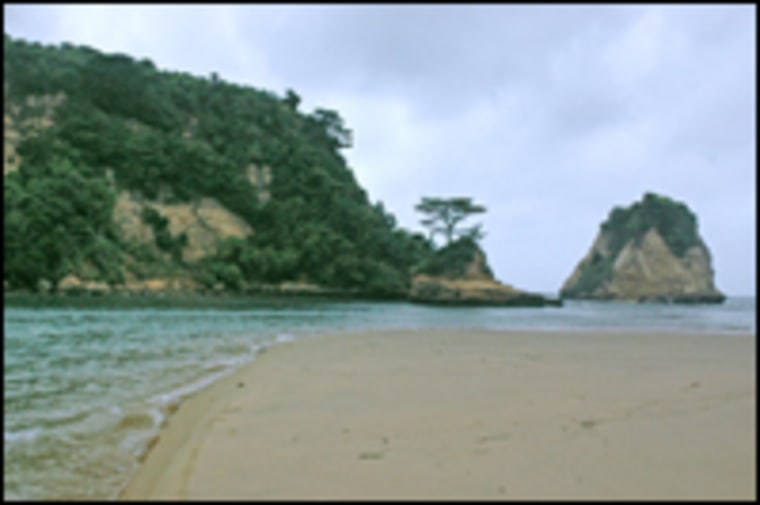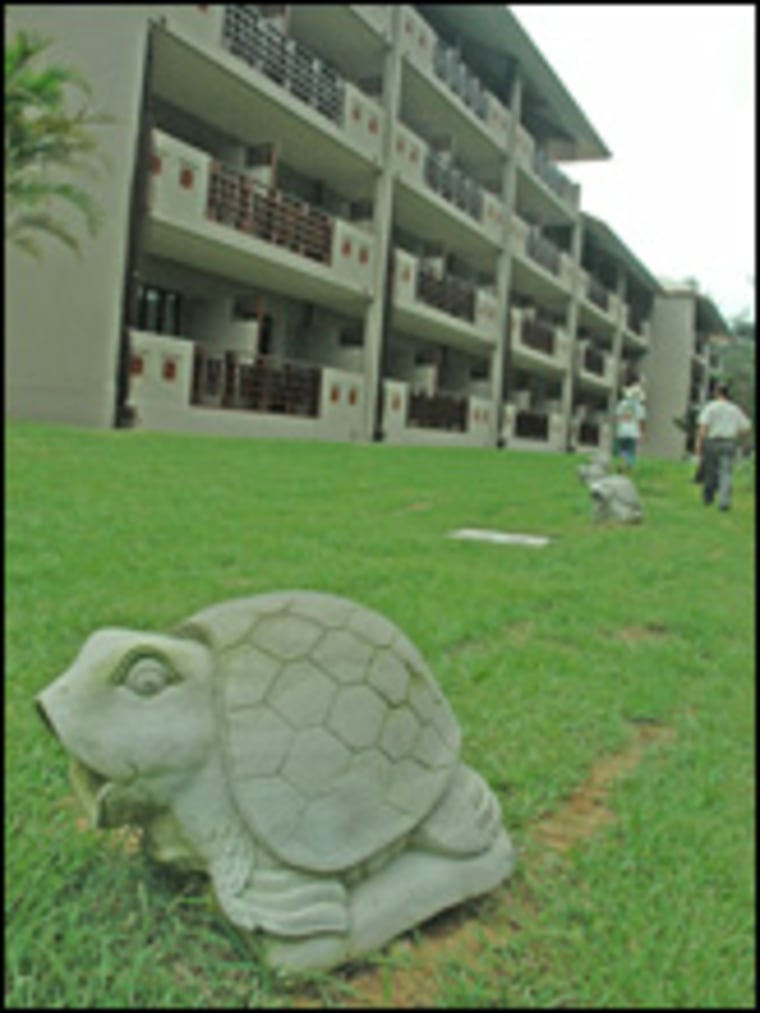The Iriomote cat is a survivor. For centuries, it employed the surest survival technique of all -- avoiding humans -- before being scientifically described for the first time in 1967 by Dr. Yoshimori Imaizumi of Tokyo's National Science Museum.
Its home, Iriomote Island, is one of the southernmost points in Japan. Located more than 1,200 miles from Tokyo, Iriomote is often called Japan's last true wilderness. With 90 percent of its land still undeveloped, this sparsely populated tropical ecosystem has been the perfect hiding place for the yamaneko (literally "mountain cat"). Favoring dense rainforests and beaches, it hunts and breeds in the island's lush mangrove stands.
Unfortunately, freedom from the heavy-handed interference of Homo sapiens recently came to an abrupt end. A new resort hotel has just opened on Todomari Beach, one of Iriomote's most treasured natural spots, and environmentalists are outraged at the development's potential impact on island wildlife.

"This beach is a precious place; it is not the place to build a hotel," says local activist Kinsei Ishigaki, standing on the beach, only 20 feet from the new resort. The four-story hotel already has 141 rooms open for business, and will ultimately be expanded into a huge compound with shops and restaurants.
Though this type of development is common to mainland Japan, most Iriomote residents flinch at the idea of attracting so many guests. While the island is the second largest in the Ryukyu chain in southwestern Japan, its 70,000 acres are home to just 2,100 people. That averages out to about 19 people per square mile, compared to a whopping 865 in Japan at large.
Before the hotel project, human activities had barely intruded on Iriomote's wildlife habitat. Farmers cleared some acreage to grow sugarcane, pineapples, and other crops. And recently the island began to draw visitors, with 360,000 coming last year. But the island's fledgling ecotourism industry caught the eye of Tokyo-based firm Unimat, which saw a lucrative financial opportunity and moved quickly to build Hotel Resort Nirakanai on Todomari beach, crucial habitat for the yamaneko. Even the name of the development -- which echoes that of a legendary Okinawan heaven -- enrages locals.
Heartbreak hotel
Because it bears a close resemblance to ancient felines -- and because evidence suggests it has existed for about 2 million years -- the Iriomote cat is sometimes called a living fossil. It resembles an American bobcat, but with slightly larger ears. On the island, it has prehistoric brethren in the giant sea turtles that have existed since the time of the dinosaurs. Both species, say locals, are threatened by the hotel.
No one can say for certain how many cats are left, but the most common estimate is 100 or fewer. And while endangered sea turtles historically use Todomari to lay eggs, says Ishigaki, none have returned to the beach since the resort began partial operations this past spring. Fully open to the public as of mid-July, the hotel will, he fears, permanently alter the face of Todomari beach and the nearby mouth of the Urauchi River.
"The wild cat comes often around here, along the river," says Ishigaki, gesturing from the mouth of the Urauchi back into the forested hills. "It uses the river to feed on crab and shrimp -- the yamaneko loves these foods."

The resort's impact on the cat is as yet unknown, but environmentalists question whether the shy feline will return to the beach or to the Urauchi River. Like the beach, the river too is a remarkable ecosystem where all manner of life now flourishes, including several protected species. Osprey and crested serpent eagles soar overhead, purple herons feast on fish and tiny frogs, and enormous spiders try to ensnare enormous butterflies in their silky webs.
Ecologists worry that the bright lights of the resort will shatter the river's pristine wilderness, and Ishigaki fears that pollution and water consumption by tourists will affect both the river and the sea, creating unpredictable and destructive conditions in an interconnected ecosystem. "I didn't expect so many changes so soon," he says. "It's a real tragedy."
Ishigaki, 57, was born here. His ancestors have lived on the island, as he'll proudly tell you, for 4,000 years. He is a small man -- 4 feet, 10 inches maybe -- but his muscles are coiled springs. He has the hands, feet, and skin of a man for whom the outdoors is both workplace and church. Men like him still breathe life into ancient Iriomote tales and songs about the turtle and the cat.
But you don't have to hold traditional beliefs to be up in arms about what's happening at Todomari Beach. Ecologically minded western scientists are aghast as well. "This hotel is an international monument to greed," says Peter Galvin, a biologist and Pacific director for the Center for Biological Diversity, a U.S.-based conservation group. Walking past the hotel, Galvin gestures toward decorative stone sea turtles, part of the resort's oceanic theme -- then notes with irony that these may be the only turtles anyone sees on Todomari Beach from now on.
Not enough room to swing a cat
Sightseers at Todomari marvel at the varied hues of water where the river meets the sea. Surfers come to catch perfectly shaped waves. Locals and tourists alike walk the soft, white sands, taking in views of rainforests and dramatic rock formations known as sea stacks. Visitors to Iriomote are often amazed by the diversity of life -- and shocked to learn that they are a threat to it. Some island advocates say that educating tourists about where and how to recreate is as important as saving habitat.
"It's very beautiful here, and it's very sad that the hotel will destroy this beautiful nature," says Chie Shimada, 29, a traveler from Tochigi Prefecture in mainland Japan. "But if someone gave me a ticket to this hotel, I would probably come. It's difficult to make people understand the bad things about this resort hotel."
To locals and environmentalists, though, the threat posed by the resort is obvious. They've been fighting to stop the project since November 2002. Environmental groups, including the World Wildlife Fund of Japan, called for a halt to development. Ishigaki and his allies filed suit to stop the hotel in March 2003, but the case was quickly rejected by the courts. Japan's environmental laws don't have the potency of U.S. legislation -- and many locals feel that the Tokyo central government cares little for what happens to their island, so long as mainland corporations make substantial yen.
Islanders point out that they aren't hostile to tourism, so long as it doesn't overwhelm the island. Ecotourism provides a living for locals, but many Iriomote ecotour operators are among the most vocal opponents of the new resort. They want to see their growing industry do minimal harm to wildlife. If that's not the case, Ishigaki predicts, "punishment will surely come."
By the word "punishment," he doesn't mean criminal sanction or tort claims in the courts; he's talking old-school divine retribution, and Ishigaki isn't kidding or trying to be quaint. In traditional island stories, divinity comes in the form of kamisama -- nature spirits. The sea turtles are messengers from the sea gods; the yamaneko itself is the personification of the mountain god. Hunters traditionally pray to the mountain cat before entering its territory to take wild boar, and then pray in gratitude after a successful hunt.
Already, a typhoon has buffeted the beach near the resort, eroding sands and toppling a lifeguard stand. This, says Ishigaki, is only the beginning.
